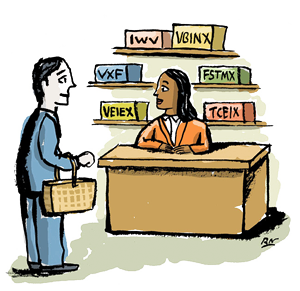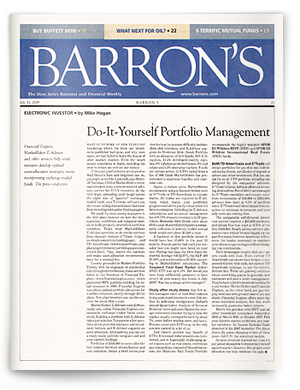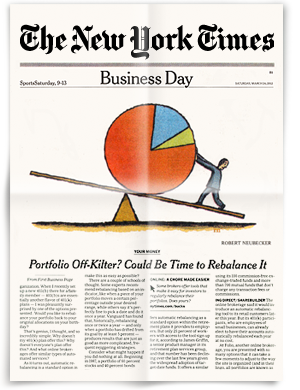Stirring Up The Right Investment Mix

Up until a few months ago, the stock market had been in an ugly dive. Now, it has roared back from its bottom. But if you think you can predict which segments of the market will do what in the next month, next year and beyond, you’re probably delusional.
Sure, trying to guess is fun, but gambling is best left for the small portion of your portfolio that you wouldn’t mind losing. Most of us should put the rest of our money in low-cost investments that try to track a particular stock, bond or other index. Paying more to managers who try to outperform the averages rarely works in the long run.
Even if you’re with me so far, you may not be ready or willing to take the next step all by yourself and actually figure out where and how to invest your money. After all, where exactly do you find a list of the best index funds? How should you allocate your money among each? And how often should you rebalance your investments?
A growing number of companies and services are popping up to answer these questions and offer low-cost ways to build an indexed portfolio. I’ve reviewed some of the best below — and thrown in a few free ones for good measure.
Marketriders
The best index assistance system of all would let you pick just how much help you want or need and then pay for it accordingly. That’s why I like a new service called MarketRiders*.
For $9.99 a month, you can tell the Web site your age, time horizon, investment experience and risk tolerance. Then it spits back a suggested asset allocation among American, international developed markets and emerging markets stocks, as well as real estate and both inflation-protected and other bonds. MarketRiders will also encourage investors who identify themselves as aggressive to invest in commodities.
- Finally, the site gives you a list of suggested exchange-traded funds with which to build the portfolio. (Such funds are similar to mutual funds but trade all day on an exchange, like stocks.) MarketRiders earns no commissions from these funds, and you use your own brokerage firm, like Schwab or Fidelity, to buy them. Then, the site sends you e-mail messages when the market has moved enough that your percentages are off and it’s time to rebalance. The note sends you back to the MarketRiders site to figure out which moves to make.
There is no minimum account size, though if you have less than $50,000 or so, rebalancing more than a couple of times a year could become expensive, since you may have to pay brokerage commissions for every fund you buy and sell.
Want more help? For $399, a registered investment adviser will hold your hand as you do all of this yourself and coach you through your first reallocation. Where does MarketRiders find such helpers? Right now, you get the hands-on assistance of the co-founders themselves, though this won’t last long.
“Our model is not to hire anyone from the financial services industry,” said Mitch Tuchman, one of the founders. “They’re brainwashed to sell products and get commissions. Our ideal would be a psychologist who is a numbers person who wanted to make money by the hour and help people out.” Underemployed therapists, there’s your cue.
For one-half of one percentage point of your assets annually, MarketRiders, based in Danville, Calif., will also do everything for you. But the founders say they’d rather not. In fact, they’re so sure that people can slide the levers and push the buttons themselves that they insist that these customers fire them each year. These clients can rehire MarketRiders once they’ve affirmed that they really do not want to touch the money themselves.
Portfolio Solutions
For all of MarketRiders’ insistence on the ease of doing it all yourself, some people simply can’t or won’t. That’s where Portfolio Solutions comes in.
For one-quarter of one percentage point of a household’s assets a year, with a minimum fee of $500 a quarter, the firm will construct and manage an indexed portfolio for you in a Charles Schwab brokerage account.
It will not, however, manage your 401(k) or 529 plan (though it can give recommendations). Nor will it give you insurance or mortgage advice. This is not full-service financial planning. It’s just investment management, using mostly index funds and other ultralow-cost vehicles.
Again, shouldn’t you be able to do this yourself? Sure, said Richard A. Ferri, the chief executive of Portfolio Solutions, which is based in Troy, Mich. In fact, he’s written several books, including “All About Index Funds” and “The ETF Book,” to help individuals figure it all out.
“But many people don’t have the time or inclination,” Mr. Ferri added. “We find that the people who contact us have come to the realization that it won’t get done or won’t get done well if they’re the ones doing it.”
Assetbuilder
The twist at AssetBuilder is that the company uses funds from a firm, Dimensional Fund Advisors, which most investors refer to as D.F.A., to construct client portfolios. D.F.A., through a variety of tweaks on the plain-vanilla index approach, aims to earn just a little bit more than normal index funds. It has had some success over the years, particularly with small-stock and value-stock funds.
Individual investors generally can’t get access to D.F.A. funds on their own. You have to go through a financial adviser who has been through D.F.A. boot camp and earns money only through client fees.
AssetBuilder, in Plano, Tex., is charging its clients less in management fees (and allowing portfolios of much smaller sizes) than just about anyone else offering D.F.A. funds. You need only $5,000 to sign up, and fees start at one-half of one percentage point annually and go down to one-fifth of a percentage point for portfolios over $20 million.
So who should not sign up for AssetBuilder? “People who need a lot of hand-holding, who like to go to a mahogany office,” said Scott Burns, the former Dallas Morning News personal finance columnist who helped start AssetBuilder.
Totally Free Options
If you don’t want to spend any money, there are some fine possibilities. IndexUniverse has a model portfolio that costs about one-eighth of a percentage point (in underlying fund fees; the site itself is free, and I’ve linked to it and many others from the version of this story at nytimes.com/yourmoney).
Mr. Burns has posted his “Couch Potato” portfolios on the AssetBuilder Web site for anyone to mimic. MarketWatch has a number of “lazy” portfolios on its site. TD Ameritrade has some nice indexing and fund-screening tools, as do other online brokerages. Please post links to other similarly helpful sites in the online comments that are next to this story on NYTimes.com.
But in the end, it doesn’t much matter which option you choose. All you need to do is stick with it over the long haul, and you’ll outperform the vast majority of professional stockbrokers — and plenty of hedge managers, too, who will have long since given up and wiped their performance records clean.
* Rebalance shares the same investment platform as MarketRiders








